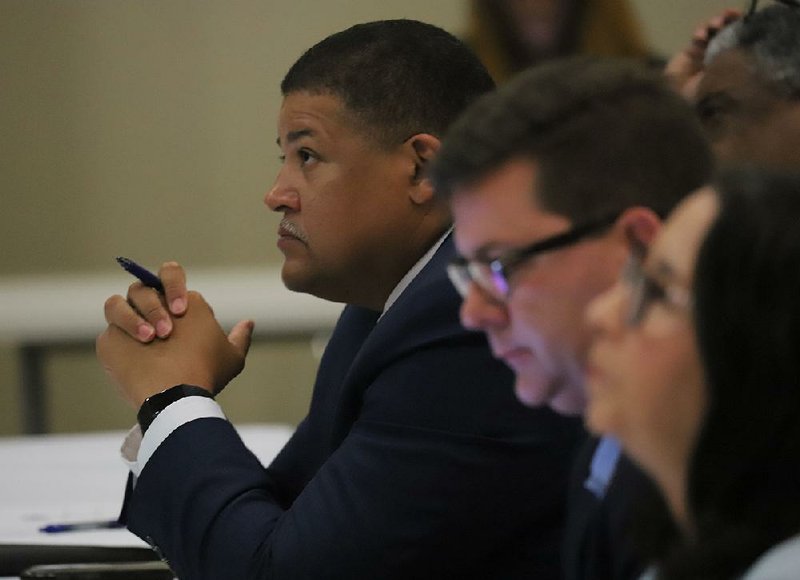Police leaders touted regional and national cooperation efforts to decrease crime and announced a plan for an in-house ballistics testing unit during a multiagency meeting Wednesday in Little Rock.
The Public Safety Summit, the first of its kind in Arkansas' capital city, gathered representatives from federal and local agencies to discuss current crime-reduction tactics at the Little Rock Police Department.
Mayor Frank Scott Jr., who earlier this month declared July "Public Safety Month," said Wednesday's event would help people better understand what the department is doing to lower violent crime.
"We all understand if you have a safe city, you'll have a more economically vibrant city," Scott said.
Among the attendees were representatives from the FBI, the Drug Enforcement Administration, the Arkansas State Police, the Crime Laboratory, U.S. attorney's office for the Eastern District of Arkansas, North Little Rock Police Department, Pulaski County sheriff's office, Arkansas Community Correction and the Department of Justice.
[Video not showing up above? Click here to watch » https://www.youtube.com/watch?v=fZSxq2KfLF8]
Capt. Ken Temple, who leads the Little Rock Police Department's special investigations division, said his department intends to create a Regional Gun Crimes Intelligence Center, where police could test ballistics in-house to more quickly solve violent crimes.
The Little Rock department currently uses the state Crime Lab's ballistics testing to record bullets used in violent crimes with the National Integrated Ballistic Information Network, a national registry of bullets data.
Bullets from crime scenes carry data points that police can use to make a "fingerprint" for the firearm and use the registry to possibly connect that weapon with other crimes. Every "match," Temple said, is a lead.
Over the past three years, the Little Rock department has more than tripled the number of bullet "matches" through the network, Temple said. There were 61 matches in 2017; 184 in 2018; and, as of Tuesday afternoon, 150 matches so far this year.
The state Crime Lab is not open outside of business hours, on weekends or on some holidays, meaning investigators often must delay testing the projectiles, Temple said. The lab also runs ballistics tests for most police departments in the state.
The department already has National Integrated Ballistic Information Network-certified detectives who can use the ballistics equipment and register new bullets, Assistant Police Chief Wayne Bewley said. Those investigators run the Little Rock tests at the Crime Lab.
"We feel we've come to the point with the education and training and our ability to enter these leads ... that we need our own system," Bewley said. "With that, we will become a center for the central Arkansas area. They'll be available 24 hours a day, seven days a week."
The department has applied for an $800,000 grant through the U.S. Department of Justice to purchase the equipment and will find out in October if it will receive the funds.
At Wednesday's meeting, Police Chief Keith Humphrey also focused heavily on community involvement and cooperation among federal, state and local police agencies.
After a mass shooting at a Little Rock nightclub in 2017 in which 28 people were injured, Humphrey said the department strengthened partnerships with the U.S. attorney's office for the Eastern District of Arkansas, the FBI, the DEA and several local agencies to address growing violent crime in the city.
Little Rock police Capt. Russell King, who leads the violent crimes unit, said the city has since seen a decrease in violent crime.
Though there has been a rise in homicides and rapes in the past two years -- increases of 10% and 13%, respectively -- King pointed to a 39% drop in robberies, a 5% drop in aggravated assault and an 11% decline in overall violent crime as proof of the department's success.
"It means we're doing something right," King said.
A part of that effort was acquiring two new technologies: ShotSpotter and the IBM Analyst's Notebook, both of which were purchased using a Technology Innovation for Public Safety grant from the Department of Justice.
The department has reapplied for the technology grant, and Humphrey and Scott agreed that the technologies were too important to the department's work to lose.
"Whatever it takes, even if the mayor has to pay that out of his own pocket," Humphrey said, smiling at a news conference after the meeting.
"That's where I'm going to step in," Scott said. "I think anyone who knows me knows how committed I am to the funding of the Little Rock Police Department."
The department has also applied for grants to aid in the purchase of body-worn cameras and expanded victims services. Little Rock grants manager Caran Curry said many of the grants are highly competitive and the department won't know if it will receive the funds for several months.
Metro on 07/18/2019

